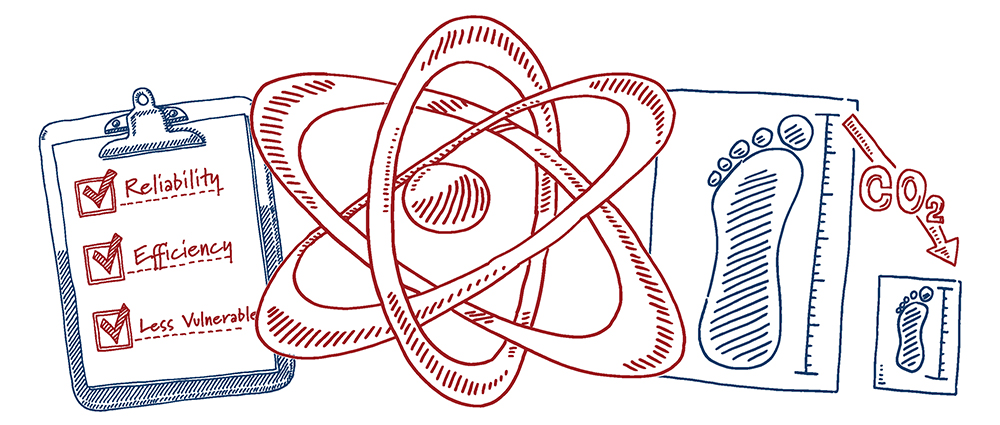Posted on July 9, 2020 by Rich Powell and Jeff Carter
America has an opportunity to take the next great leap forward and again lead the world by developing more advanced nuclear energy. America has held a nuclear innovation tradition since the first defense nuclear reactors during World War II and the early Cold War buildup. The Nuclear Energy Leadership Act (NELA) would serve as the next big nuclear innovation catalyst.
America always exhibits strength through innovation when facing adversity. Just one year after the attack on Pearl Harbor, American ingenuity and perseverance drove the first sustained, controlled nuclear chain reaction on December 2, 1942 at 3:46 p.m. from a small reactor called the Chicago Pile. Stacked in a squash court under stadium stands of the University of Chicago Stagg Field, this birth of nuclear energy spurred rapid innovation for defense applications.
Since that Chicago moment, America has consistently innovated with nuclear technology for military use to keep America safe. And in this new post-Cold War era, we face significant global security threats, especially from two major powers: Russia and China.
The time is ripe to act now, and NELA — which is cosponsored by nearly a quarter of the Senate split equally by party — would accelerate the commercialization of next generation nuclear reactors that are designed to have a small footprint, always-on reliability, increased efficiency, and can be even less vulnerable to proliferation than earlier designs.
Next Generation Nuclear Reactors Have a Small Footprint, Reliability, Efficiency, and Less Vulnerable to Proliferation

To be clear, NELA does not address nuclear weapons. However, we agree nuclear energy innovation, as history has shown, has mutually beneficial defense and commercial applications. Accordingly, adding NELA to the FY2021 National Defense Authorization Act (NDAA) makes perfect sense. Advanced nuclear energy has the attributes that support the Department of Defense’s (DoD) mission and U.S. national security. Next generation microreactors would remove the sometimes lethal logistics for troops transporting fossil fuel in hostile regions and could power land-based military and strategic assets, including our U.S. strategic nuclear deterrent.
The interconnection of nuclear energy and national security is an American tradition, but beyond that, NELA includes a significant role for DoD. In recent years, the DoD has explored the benefits advanced microreactors could bring to the U.S. military. Multiple branches recognize the tremendous value of the 24/7 reliability. Moreover, the bill requires the Secretary of Energy to coordinate with the Secretary of Defense on a long-term nuclear power purchase agreement pilot program. Private companies who partner with DoD would be eligible for the demonstration project section of the bill. Plus, NELA’s advanced nuclear fuel section requires consideration of the DoD’s fuel needs. America has let key domestic nuclear materials, manufacturing, and uranium enrichment for defense application atrophy to the point of extinction. With NELA on NDAA, we can begin to reverse this.
Ceding international competitiveness on nuclear energy to countries like China and Russia is top of mind for DoD and U.S. intelligence agencies. While U.S. modernization is just beginning, these countries have already modernized and are expanding their strategic nuclear deterrent. China’s commercial nuclear energy manufacturing capabilities may now exceed that of the U.S. and our allies’ combined, and Russia is not far behind. Furthermore, China and Russia are developing a stronghold on international nuclear energy markets – increasing soft power in strategic regions where our geopolitical advantages may be compromised.
Russia and China Are Winning the Race to Nuclear Modernization

China and Russia — empowered by the lack of action in the U.S. — are developing and exporting advanced reactors around the world. Russia is building 7 reactors in Asia with 22 more ordered or under contract in Asia and Europe, and it has more than 2 dozen proposals advancing exports into Africa, according to the World Nuclear Association. Bloomberg recently reported that China is on pace to go from 49 gigawatts of nuclear capacity in 2019 to 100 gigawatts in 2030. Chinese officials also stated they want to build 6-8 reactors a year. We are currently building two. In 1974, we brought a dozen commercial reactors online in one year.
Like we just saw with NASA’s SpaceX launch, by innovating, we can do it again. However, if we do not reassert our leadership in this geopolitically important field of nuclear energy now, we risk falling way behind – or losing it. We need NELA on the defense bill to get advanced nuclear energy back on the launch pad.
Jeff Crater is the Co-founder and Managing Director of the bipartisan Advanced Nuclear Weapons Alliance Action that advocates for the modernization of the U.S. strategic nuclear deterrent with key decision makers in Congress and across the Federal government.
View more of Our Take and let us know what you think at jaylistens@clearpath.org.
